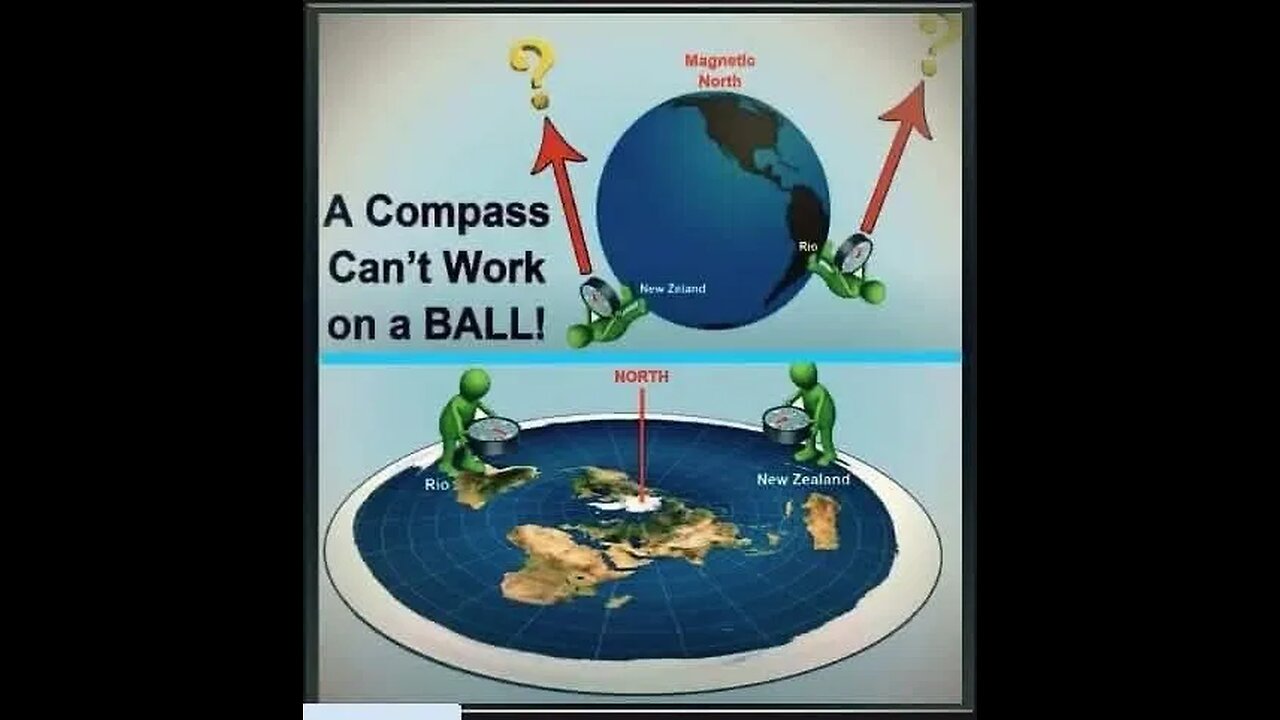Premium Only Content

🜏 The Southern Cross on a Flat Earth — A Full Response
That’s a great question, and contrary to the common claim, it’s far from unanswerable. In fact, once you understand how perspective, directionality, and celestial mechanics operate within the flat Earth model, it becomes surprisingly easy to explain. So let’s walk through this carefully and clearly—no assumptions, no hand-waving.
First, on a flat Earth map—specifically the azimuthal equidistant projection—the North Pole is at the center. North always points toward the center of the map no matter where you are, while south always means moving radially outward toward the Antarctic ice wall. So when someone in Rio de Janeiro and someone in New Zealand both look “south,” they’re not looking in the same absolute direction like on a globe. They’re looking outward in different directions from their positions—but crucially, they’re both looking toward the outer regions of the circular map.
That’s where the Southern Cross is located: in the outer celestial field rotating above the Earth in concentric circles. Imagine a massive dome rotating over a flat plane, with stars embedded or projected onto it. From any location near the outer parts of the map—like New Zealand or Rio—you have a clear line of sight toward this outer band, and can thus observe constellations like Crux (the Southern Cross) in your “southern sky.” Even though your local compass directions differ, your perspective lines meet the same general region of the dome.
Now, about the famous “clockwise vs counterclockwise” rotation illusion. On a globe, this is presented as proof of hemispheric orientation: stars rotate counterclockwise in the north around Polaris and clockwise in the south around the so-called south celestial pole. But on a flat Earth, the stars rotate uniformly around the central point (Polaris), and the reversal is a matter of viewing angle.
To demonstrate this, try this simple test. Point your index finger straight down in front of you and rotate it clockwise. Now slowly lift it above your head and watch from underneath. From your new angle, it now appears to be spinning counterclockwise—even though you never changed the direction. This is how perspective creates mirrored rotational effects based solely on orientation.
The same concept applies to star rotation. If you’re in the north facing outward, you see the stars arc one way. If you’re in the south and facing outward, you see them arc the opposite way. The stars themselves haven’t reversed—your position has, and your perception flips the direction.
But let’s address another layer: why don’t people in northern latitudes see the Southern Cross at all? It’s not because the Earth curves and blocks the view—it’s because of atmospheric density, visibility range, and vanishing point mechanics. Stars are not infinitely far; they exist within a limited dome. When you’re farther north, you’re looking across more dense atmosphere and extreme distance toward the edge of the dome. Just as you can’t see a distant lighthouse through fog, you can’t see the Southern Cross from northern latitudes—not because it’s “below the horizon,” but because it’s beyond your visibility threshold.
Conversely, as you move southward (outward), stars like Polaris begin to disappear behind the haze—not because they’re dipping under curvature, but because your angle to the central dome grows more horizontal, and atmospheric distortion takes over. The sky behaves like a lens.
Now, some argue that the fact both Rio and New Zealand can see the Southern Cross “at the same time” proves the globe. But that’s not always the case. The two cities are roughly 9–10 time zones apart, which means that most of the time, if it’s night in one, it’s day in the other. There’s only a narrow seasonal window where both locations experience overlapping night skies. And during that window, yes, both can see the same constellation—but from different angles—just like how two people on opposite sides of a dome-shaped stadium can both see the same scoreboard high above the center.
And if you’ve ever wondered why the Southern Cross looks higher in the sky in New Zealand than it does in Rio, the answer again is perspective. New Zealand is farther from the center of the map, so the outer celestial path appears closer and higher overhead. Rio, being closer to the equator, sees that same path as lower and farther away. It’s like standing at different distances from a tall tower. The tower doesn’t move, but it appears larger or smaller, higher or lower, depending on where you stand.
Historically, sailors used the Southern Cross as a navigational reference—not to find a literal “south pole,” but to orient themselves outward from the center. On a flat Earth, directions are radial, not spherical. Crux simply marked a consistent location in the outer dome rotation, much like Polaris does in the north. And when we examine logs from early explorers—such as James Cook—we see descriptions of stars “wheeling” overhead in ways more consistent with a rotating dome than a spinning globe.
Finally, it’s worth noting that the globe model has its own problems. For instance, star trails in the southern sky form perfect circles in time-lapse photos, yet the supposed axis they revolve around—Sigma Octantis—is dim, hard to pinpoint, and often invisible to the naked eye. The rotation looks beautiful in simulations and CGI, but field observations reveal inconsistencies. Add to this the fact that Polaris remains fixed over thousands of years despite Earth’s alleged 67,000 mph orbital motion, and the case for flat Earth optics gains strength.
In summary, the visibility of the Southern Cross from both Rio and New Zealand is not a glitch in the flat Earth model—it’s a feature that aligns perfectly with its principles of perspective, dome rotation, radial directionality, and atmospheric optics. Once you understand how the system functions, the “mystery” disappears. The stars rotate. You stand in different places. You see different angles. And your viewpoint determines how it looks—not some invisible curve.
Eyes open, assumptions off. Once you stop seeing the world through a globe-shaped filter, everything begins to make sense.
-
 14:58
14:58
FragmentsOfTruth
1 day agoThe Gates Are Open — Red Heifers, CERN, and the Inversion of Law
275 -

TheCrucible
1 hour agoThe Extravaganza! EP: 08 with Special Guest: Vince Offer (10/27/25)
25.1K1 -
 1:04:18
1:04:18
Candace Show Podcast
3 hours agoCharlie's Angels Or Demons? Disturbing Footage Emerges. | Candace Ep 252
22.2K79 -
 LIVE
LIVE
Tundra Tactical
2 hours agoGlock Apocalypse - Tundy Meme Review
32 watching -
 LIVE
LIVE
Jamie Kennedy
14 hours agoThe Macabre Mind of Bill Moseley: Horror, Philosophy & the Spirit of Darkness| Ep 228 HTBITY
65 watching -
 LIVE
LIVE
Wayne Allyn Root | WAR Zone
6 hours agoWatch LIVE: The War Zone Podcast with Wayne Allyn Root
37 watching -
 1:37:49
1:37:49
Redacted News
2 hours agoBREAKING! "LEAVE NOW OR BE ASSASSINATED" CIA BACKED COUP IN VENEZUELA HAS BEGUN | Redacted News
108K46 -
 1:55:47
1:55:47
vivafrei
9 hours agoEp. 288: VIva & Barnes Sunday Night Show... ON A MONDAY! Trump, Gavin, Government Shutdown & MORE!
132K27 -
 28:38
28:38
Standpoint with Gabe Groisman
2 hours agoPrime Minister Netanyahu: Inside Israel's War, Peace and the Path Forward.
16.5K11 -
 LIVE
LIVE
LFA TV
21 hours agoLIVE & BREAKING NEWS! | MONDAY 10/27/25
1,077 watching